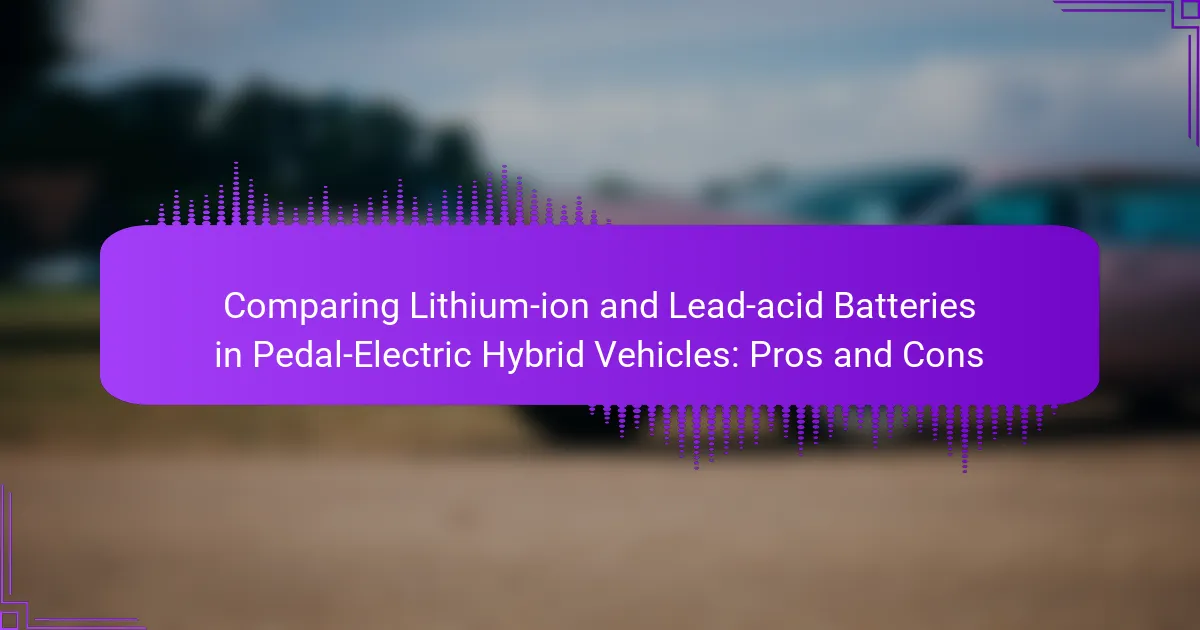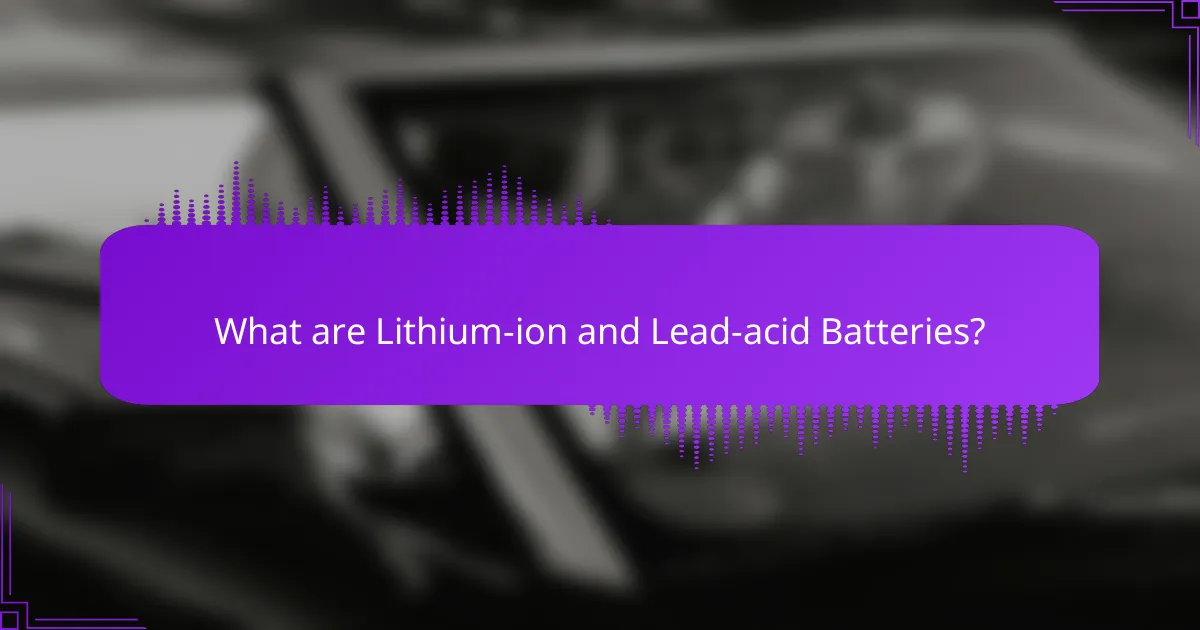
What are Lithium-ion and Lead-acid Batteries?
Lithium-ion batteries are rechargeable energy storage devices known for their high energy density and efficiency. They use lithium compounds as the primary component in their electrochemistry. These batteries typically have a longer lifespan and faster charging capabilities compared to other types. Common applications include smartphones, laptops, and electric vehicles.
Lead-acid batteries are also rechargeable but are heavier and have a lower energy density. They consist of lead dioxide and sponge lead, immersed in sulfuric acid. Lead-acid batteries have been in use for over a century. They are commonly found in automotive applications due to their reliability and cost-effectiveness. However, they have a shorter lifespan and longer charging times compared to lithium-ion batteries.
How do Lithium-ion and Lead-acid Batteries function?
Lithium-ion batteries function through electrochemical reactions that involve the movement of lithium ions between the anode and cathode during charging and discharging. In contrast, lead-acid batteries operate through the chemical reaction of lead dioxide and sponge lead in sulfuric acid.
When lithium-ion batteries charge, lithium ions move from the cathode to the anode, storing energy. During discharge, the ions flow back to the cathode, releasing energy. Lithium-ion batteries are known for their high energy density, longer lifespan, and faster charging capabilities.
Lead-acid batteries, however, produce electricity through the oxidation of lead and the reduction of lead dioxide, resulting in lead sulfate and water. They are heavier and have a lower energy density compared to lithium-ion batteries. Lead-acid batteries are generally less efficient, with a shorter cycle life and longer recharge times.
The operational principles of both battery types highlight their respective advantages and disadvantages in applications such as pedal-electric hybrid vehicles.
What are the key components of Lithium-ion batteries?
The key components of Lithium-ion batteries are the anode, cathode, electrolyte, and separator. The anode is typically made of graphite, which stores lithium ions during charging. The cathode is often composed of lithium metal oxides, providing a source of lithium ions during discharge. The electrolyte facilitates the movement of lithium ions between the anode and cathode. The separator is a porous membrane that prevents direct contact between the anode and cathode while allowing ion flow. These components work together to enable efficient energy storage and release, making Lithium-ion batteries suitable for various applications, including electric vehicles.
What are the key components of Lead-acid batteries?
The key components of lead-acid batteries are the positive plate, negative plate, electrolyte, separator, and battery casing. The positive plate is typically made of lead dioxide. The negative plate consists of sponge lead. The electrolyte is a sulfuric acid solution that facilitates the chemical reaction. The separator prevents the plates from short-circuiting while allowing ion flow. The battery casing holds all components together and protects them from external damage. These components work together to store and release electrical energy through electrochemical reactions.
What are the primary differences between Lithium-ion and Lead-acid Batteries?
Lithium-ion batteries are lighter, more efficient, and have a longer lifespan compared to lead-acid batteries. Lithium-ion batteries typically weigh 30-50% less than lead-acid batteries for the same energy capacity. They also have a higher energy density, providing 150-200 Wh/kg versus lead-acid’s 30-50 Wh/kg. Lithium-ion batteries can endure more charge cycles, lasting 2,000 to 5,000 cycles, while lead-acid batteries usually last 500 to 1,000 cycles. Furthermore, lithium-ion batteries charge faster, often reaching full charge in 1-2 hours, compared to lead-acid, which may take 8-12 hours. Lithium-ion batteries also have a lower self-discharge rate of about 2-5% per month, while lead-acid batteries can discharge 10-15% monthly. Additionally, lithium-ion batteries operate effectively in a wider temperature range, enhancing their performance in various conditions.
How do their energy densities compare?
Lithium-ion batteries have a higher energy density compared to lead-acid batteries. Lithium-ion batteries typically offer energy densities ranging from 150 to 250 Wh/kg. In contrast, lead-acid batteries usually have energy densities between 30 to 50 Wh/kg. This significant difference means lithium-ion batteries can store more energy in a smaller and lighter package. Consequently, this makes them more suitable for applications requiring efficient energy use, such as in pedal-electric hybrid vehicles. The higher energy density of lithium-ion batteries contributes to longer driving ranges and reduced weight in these vehicles.
What are the differences in lifespan and cycling performance?
Lithium-ion batteries have a longer lifespan and better cycling performance compared to lead-acid batteries. Lithium-ion batteries typically last between 8 to 15 years, while lead-acid batteries last around 3 to 5 years. In terms of cycling performance, lithium-ion batteries can endure 500 to 2000 charge cycles, whereas lead-acid batteries usually handle only 200 to 300 cycles effectively. Lithium-ion batteries also maintain a higher energy density, allowing for more effective energy storage and discharge. This leads to improved efficiency in pedal-electric hybrid vehicles, enhancing overall performance.
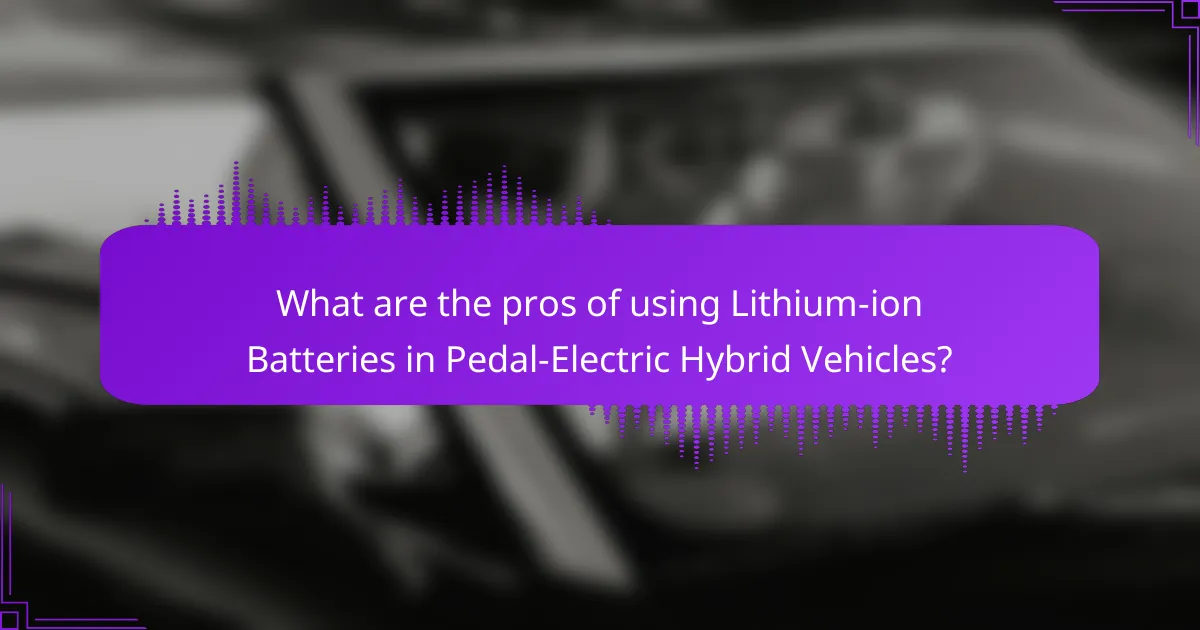
What are the pros of using Lithium-ion Batteries in Pedal-Electric Hybrid Vehicles?
Lithium-ion batteries offer several advantages in pedal-electric hybrid vehicles. They have a higher energy density compared to lead-acid batteries. This means they can store more energy in a smaller and lighter package. Lithium-ion batteries also have a longer lifespan, typically lasting over 2,000 charge cycles. This longevity reduces the frequency of battery replacements. Additionally, they charge faster than lead-acid batteries, allowing for quicker turnaround times. Lithium-ion batteries also have a lower self-discharge rate, retaining their charge better when not in use. Finally, they are more environmentally friendly, as they contain fewer toxic materials compared to lead-acid batteries. These benefits make lithium-ion batteries a preferred choice for modern pedal-electric hybrid vehicles.
What benefits do Lithium-ion Batteries provide?
Lithium-ion batteries provide high energy density, enabling longer usage times for devices. They have a lightweight design, making them ideal for applications in electric vehicles. Lithium-ion batteries exhibit low self-discharge rates, retaining charge for extended periods. They also support fast charging, reducing downtime for users. Their lifespan is significantly longer compared to traditional batteries, often exceeding 2,000 charge cycles. Additionally, they have a lower environmental impact due to reduced toxic materials. These benefits make lithium-ion batteries a preferred choice in modern technology and electric vehicles.
How do Lithium-ion Batteries enhance vehicle performance?
Lithium-ion batteries enhance vehicle performance by providing higher energy density and faster charging times. Their energy density allows for more energy storage in a smaller, lighter package. This reduces the overall weight of the vehicle, improving efficiency and handling. Faster charging times enable quicker turnaround for users, increasing convenience.
Additionally, lithium-ion batteries have a lower self-discharge rate compared to lead-acid batteries. This means they retain their charge longer when not in use. They also support higher discharge rates, which is crucial for delivering power during acceleration.
Research shows that electric vehicles using lithium-ion batteries can achieve ranges of over 300 miles on a single charge, compared to lead-acid alternatives. This range contributes to improved usability and performance in hybrid vehicles.
What are the environmental impacts of Lithium-ion Batteries?
Lithium-ion batteries have significant environmental impacts. Their production involves mining raw materials like lithium, cobalt, and nickel. This mining process can lead to habitat destruction and water pollution. Additionally, the extraction of these minerals often occurs in regions with poor environmental regulations.
The manufacturing process of lithium-ion batteries is energy-intensive, contributing to greenhouse gas emissions. When these batteries reach the end of their life cycle, improper disposal can cause toxic substances to leach into the environment. Recycling rates for lithium-ion batteries remain low, further exacerbating waste issues.
Studies indicate that the environmental footprint of lithium-ion batteries can be reduced through better recycling practices and the use of alternative materials. For instance, research published in the journal “Nature Sustainability” highlights that improved battery recycling can significantly lower the environmental impact.
What are the cons of using Lithium-ion Batteries?
Lithium-ion batteries have several cons. They can be expensive compared to other battery types. Their lifespan is generally shorter, typically lasting 2 to 3 years with proper care. Overcharging can lead to thermal runaway, resulting in fires or explosions. They also require specific charging conditions to maintain performance. Lithium-ion batteries can degrade in extreme temperatures, affecting their efficiency. Additionally, recycling options for lithium-ion batteries are limited, leading to environmental concerns. Their production involves mining materials, which can harm ecosystems.
What are the costs associated with Lithium-ion Batteries?
The costs associated with Lithium-ion batteries primarily include manufacturing, materials, and maintenance expenses. Manufacturing costs can range from $100 to $300 per kilowatt-hour. The price of raw materials, such as lithium, cobalt, and nickel, significantly impacts overall costs. These materials have seen price fluctuations due to market demand. Additionally, maintenance costs are generally lower compared to other battery types, as Lithium-ion batteries require less frequent replacements. The average lifespan of these batteries is around 10 to 15 years, providing better long-term value. In summary, while initial costs may be higher, the overall efficiency and longevity can justify the investment.
What safety concerns are linked to Lithium-ion Batteries?
Lithium-ion batteries pose several safety concerns. They can overheat, leading to thermal runaway, which may cause fires or explosions. Additionally, physical damage to the battery can result in short circuits. Manufacturing defects can also lead to failures, increasing risks during use. Furthermore, improper charging can cause battery swelling or leakage of hazardous materials. The National Fire Protection Association reported that lithium-ion battery incidents have increased as their usage has grown. Proper handling and storage are essential to mitigate these risks.
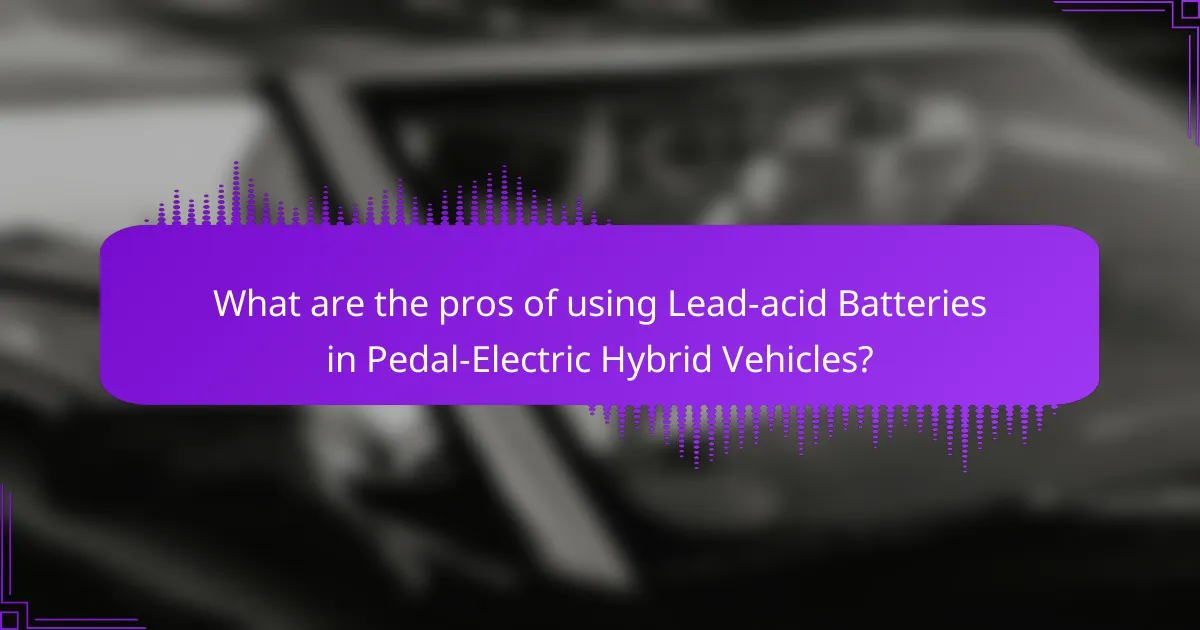
What are the pros of using Lead-acid Batteries in Pedal-Electric Hybrid Vehicles?
Lead-acid batteries offer several advantages in pedal-electric hybrid vehicles. They are cost-effective, typically costing less than lithium-ion batteries. This affordability makes them accessible for manufacturers and consumers. Lead-acid batteries have a well-established recycling infrastructure. Approximately 99% of lead-acid batteries are recycled, reducing environmental impact. They also provide reliable performance in various temperature ranges. This reliability ensures consistent operation in different climates. Lead-acid batteries have a robust discharge rate. They can deliver high currents for short periods, which is beneficial for acceleration. Their weight is generally higher, which can enhance stability in certain vehicle designs. Overall, these attributes make lead-acid batteries a practical choice for pedal-electric hybrid vehicles.
What advantages do Lead-acid Batteries offer?
Lead-acid batteries offer several advantages, including cost-effectiveness and reliability. They are generally less expensive than lithium-ion batteries, making them accessible for various applications. Lead-acid batteries have a well-established recycling infrastructure, which promotes sustainability. Their robust design allows them to withstand harsh conditions and deliver consistent performance. Additionally, they provide high surge currents, making them suitable for applications requiring quick bursts of energy. Lead-acid batteries also have a long history of use, which contributes to their reliability and familiarity in the market. Their ability to operate effectively in a wide temperature range further enhances their versatility.
How do Lead-acid Batteries contribute to affordability?
Lead-acid batteries contribute to affordability primarily due to their lower initial purchase cost compared to lithium-ion batteries. The average price of lead-acid batteries is significantly less, often ranging from $100 to $200 for standard models. This makes them accessible for a wide range of consumers and applications.
Additionally, lead-acid batteries have a well-established manufacturing process, which helps keep production costs down. Their widespread availability in the market further enhances affordability.
Moreover, lead-acid batteries are often used in applications where high energy density is not critical, making them suitable for budget-conscious consumers. The lower cost of replacement and maintenance also adds to their economic appeal.
In summary, the combination of lower purchase prices, established manufacturing, and suitable applications makes lead-acid batteries a more affordable option for many users.
What is the recycling process for Lead-acid Batteries?
The recycling process for lead-acid batteries involves several key steps. First, used batteries are collected and transported to recycling facilities. Next, the batteries are broken down into their components. This includes separating the lead, sulfuric acid, and plastic casing. The lead is purified and reused in new batteries. The sulfuric acid is neutralized and converted into sodium sulfate, which can be used in detergents or glass manufacturing. The plastic casing is also recycled into new products. According to the International Lead Association, over 95% of lead-acid battery components can be recycled, making them one of the most recycled consumer products.
What are the disadvantages of using Lead-acid Batteries?
Lead-acid batteries have several disadvantages. They are heavier than alternative battery types, making them less suitable for weight-sensitive applications. Their energy density is low, providing less energy per unit weight compared to lithium-ion batteries. The lifespan of lead-acid batteries is shorter, typically lasting 3 to 5 years under optimal conditions. They also require regular maintenance, including checking fluid levels and equalizing charges. Additionally, lead-acid batteries have a slower charging time, often taking several hours to recharge fully. They can suffer from sulfation if left discharged, which reduces their efficiency. Lastly, lead-acid batteries contain toxic lead and sulfuric acid, posing environmental hazards if not disposed of properly.
How do Lead-acid Batteries compare in terms of weight and efficiency?
Lead-acid batteries are generally heavier and less efficient compared to other battery types. A typical lead-acid battery weighs about 30-50% more than a lithium-ion battery with the same energy capacity. The energy efficiency of lead-acid batteries is around 70-80%, while lithium-ion batteries can achieve efficiencies of 90-95%. This difference in efficiency impacts the overall performance in applications like pedal-electric hybrid vehicles. The higher weight of lead-acid batteries can also affect vehicle dynamics and energy consumption.
What limitations do Lead-acid Batteries have in modern applications?
Lead-acid batteries have several limitations in modern applications. They have a lower energy density compared to lithium-ion batteries. This means they store less energy for the same weight. Their cycle life is also shorter, typically lasting about 500-1,000 cycles. In contrast, lithium-ion batteries can last over 2,000 cycles. Lead-acid batteries are heavier, making them less suitable for lightweight applications. They also have a slower charging rate, which can be a disadvantage in time-sensitive situations. Additionally, they suffer from sulfation if not maintained properly, reducing their efficiency. These limitations hinder their use in advanced technologies like pedal-electric hybrid vehicles.
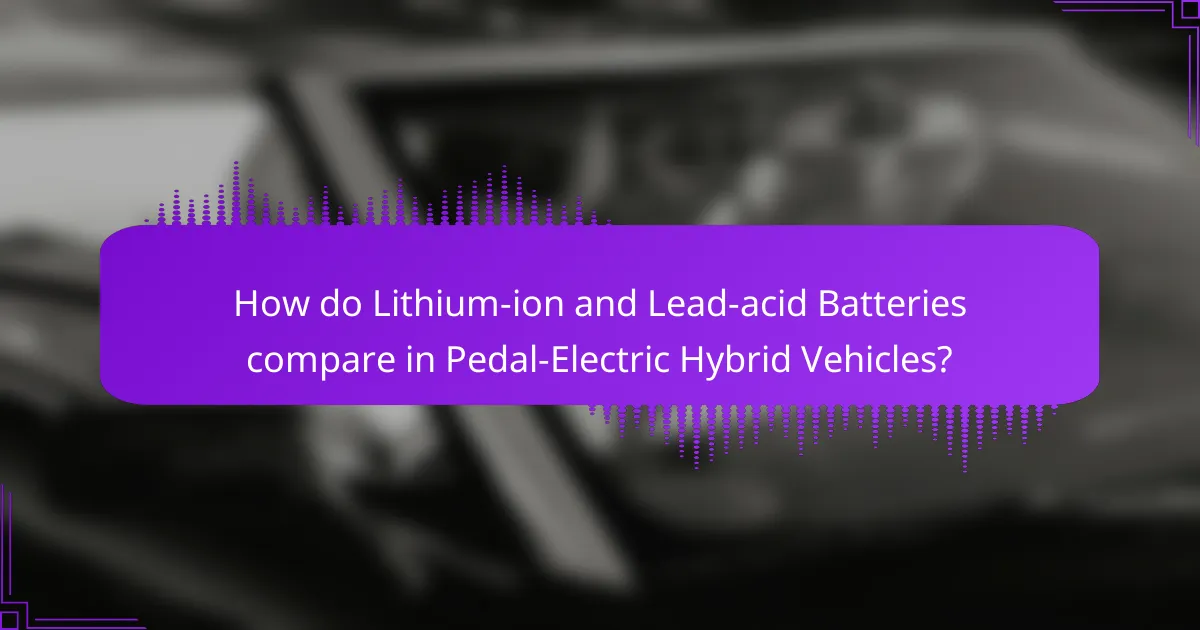
How do Lithium-ion and Lead-acid Batteries compare in Pedal-Electric Hybrid Vehicles?
Lithium-ion batteries outperform lead-acid batteries in pedal-electric hybrid vehicles. They offer higher energy density, which translates to longer driving ranges. Lithium-ion batteries typically have a lifespan of 2,000 to 5,000 charge cycles. In contrast, lead-acid batteries usually last for only 500 to 1,000 cycles. Lithium-ion batteries also charge faster, taking a few hours compared to lead-acid’s longer charging times. Additionally, lithium-ion batteries are lighter, which enhances vehicle efficiency. Lead-acid batteries are generally more affordable upfront but incur higher long-term costs due to shorter lifespan and inefficiency. Therefore, while lead-acid batteries may seem economical initially, lithium-ion batteries provide better performance and value over time.
What factors should be considered when choosing between Lithium-ion and Lead-acid Batteries?
When choosing between Lithium-ion and Lead-acid batteries, consider energy density, lifespan, weight, and cost. Lithium-ion batteries have a higher energy density, meaning they store more energy in a smaller size. They typically last longer, with a lifespan of 2,000 to 5,000 cycles compared to Lead-acid’s 500 to 1,000 cycles. Weight is another critical factor; Lithium-ion batteries are lighter, improving vehicle efficiency. Cost also differs significantly; Lithium-ion batteries are more expensive upfront but offer better long-term value due to their longevity. Additionally, charging times and temperature sensitivity may affect performance. Lithium-ion batteries charge faster but can be sensitive to high temperatures. Lead-acid batteries are more tolerant to temperature variations but take longer to charge. These factors collectively influence the decision based on specific vehicle needs and usage scenarios.
How do maintenance requirements differ between the two battery types?
Lithium-ion batteries require significantly less maintenance compared to lead-acid batteries. Lithium-ion batteries do not need regular topping off with water. They also have built-in management systems that optimize performance and longevity. In contrast, lead-acid batteries require periodic checks of electrolyte levels and may need water added to prevent damage. Additionally, lead-acid batteries must be kept charged to avoid sulfation, which can degrade their capacity. This difference in maintenance needs highlights the convenience of lithium-ion batteries for users. According to a study by the Department of Energy, lithium-ion batteries can last up to twice as long as lead-acid batteries with minimal maintenance.
What are the charging time differences between Lithium-ion and Lead-acid Batteries?
Lithium-ion batteries charge significantly faster than lead-acid batteries. Typically, a lithium-ion battery can be fully charged in 1 to 4 hours. In contrast, lead-acid batteries may take 8 to 12 hours or more to reach full charge. The difference in charging times is due to the chemical composition and design of the batteries. Lithium-ion batteries have higher charge and discharge efficiency. This efficiency allows them to accept energy more quickly. Lead-acid batteries have a slower charge acceptance rate. This results in longer charging durations. Therefore, for applications requiring rapid recharging, lithium-ion batteries are preferred.
What are the best practices for using these batteries in Pedal-Electric Hybrid Vehicles?
Charge lithium-ion batteries fully before first use. This maximizes their capacity and lifespan. Avoid deep discharging lithium-ion batteries. Keeping the charge between 20% and 80% prolongs battery health. Store batteries in a cool, dry place to prevent overheating. High temperatures can degrade battery performance and lifespan. Regularly check battery connections for corrosion or damage. Clean connections to ensure efficient power transfer. Use the vehicle’s regenerative braking feature to recharge the battery. This practice enhances overall efficiency. Follow manufacturer guidelines for maintenance and replacement schedules. Adhering to these practices ensures optimal performance of batteries in pedal-electric hybrid vehicles.
How can users maximize battery life and performance?
Users can maximize battery life and performance by implementing several key strategies. First, they should avoid deep discharges of the battery. Keeping the battery charge between 20% and 80% can significantly extend its lifespan. Second, users should maintain optimal operating temperatures. Lithium-ion batteries perform best at temperatures between 20°C and 25°C. Third, regular maintenance is crucial. This includes checking for corrosion and ensuring proper connections. Fourth, users should minimize exposure to extreme temperatures. High heat can degrade battery performance, while extreme cold can reduce capacity. Additionally, users should limit the use of power-hungry applications. This helps in conserving battery life during operation. Lastly, utilizing energy-saving modes can enhance overall efficiency. These practices can lead to improved battery longevity and performance in pedal-electric hybrid vehicles.
What troubleshooting tips are available for both battery types?
Check for loose connections or corrosion on battery terminals. Ensure that terminals are clean and securely attached. Test the voltage using a multimeter to verify the battery’s charge. If the voltage is low, consider recharging the battery. Inspect for physical damage or swelling in both battery types. Replace any damaged batteries immediately. Monitor the battery’s temperature during operation to prevent overheating. For lead-acid batteries, ensure proper electrolyte levels are maintained. For lithium-ion batteries, avoid deep discharges to prolong lifespan. Regular maintenance can help identify issues early and ensure optimal performance.
The main entity of this article is the comparison between Lithium-ion and Lead-acid batteries in the context of pedal-electric hybrid vehicles. The article provides a detailed analysis of the characteristics, advantages, and disadvantages of both battery types, focusing on their energy density, lifespan, charging efficiency, and environmental impacts. Key components of each battery type are outlined, along with their operational principles and performance metrics in hybrid vehicle applications. Additionally, the article discusses maintenance requirements, safety concerns, and best practices for maximizing battery life and performance, offering a comprehensive overview for informed decision-making.
